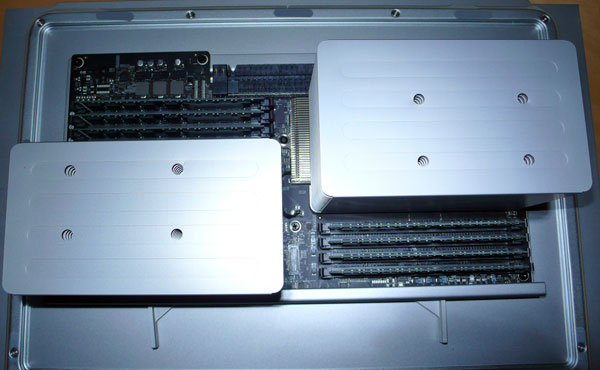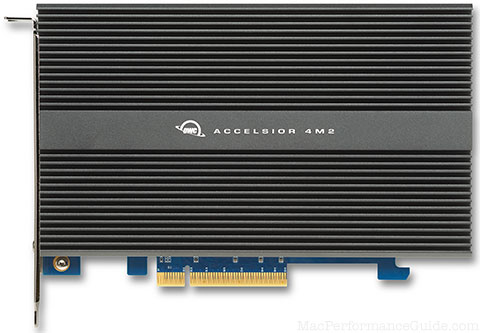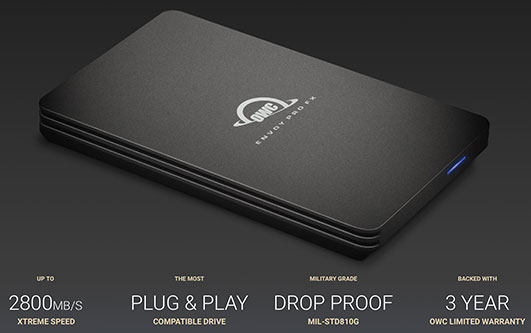
$220 SAVE $130 = 37.0% Western Digital 16.0TB Western Digital Ultrastar DC HC550 3.5-in… in Storage: Hard Drives
|

|

|

|

|

|

|

|

|

|
Introduction to Mac Pro Nehalem
Related: computer display, display connectivity, DisplayPort, hard drive, Mac Pro, Macs, memory, Photoshop
Apple began shipping the new Mac Pro based on the Intel Xeon “Nehalem” processors in March 2009 (see Apple’s User Guide). We’ll call these the MP09 and the MP08, with the following variants:
MP08 = 2008 Mac Pro 2.8GHz, dual-CPU (eight core)
MP08-3.2 EST = estimated time for 2008 Mac Pro 3.2GHz, based on MP08
MP09 = 2009 Mac Pro “Nehalem” 2.93GHz, dual-CPU
MP09-sc = 2009 Mac Pro “Nehalem” 2.93GHz, single-CPU
Most tests include comparisons between the single and dual CPU MP09. See the Conclusions for thoughts about single vs dual CPU models.
How much faster is MP09 than MP08?
Looking for the ultimate speedy feel? See How to make your Mac feel lighting-fast.
In most cases, about 10-30% faster than a 2.8GHz MP08, and about 0-20% faster than a 3.2GHz MP08. Exceptions include applications that can utilize more than 8 cores effectively.
In effect, the MP09 is a little faster at the same clock speed, but offers 16 virtual cores capable of 50-80% more raw computing power. Unfortunately, very few programs can use that power, think science, math and video here, not everyday photo applications.
A variety of tests were run, with the MP09 showing the best performance in nearly all, but not every test. Specialty and/or well-designed software that takes advantage of all 16 virtual cores will offer the best results, but few programs achieve this.
Configuring for optimal performance
Configuring an optimal machine is more or less the same as any other Mac: adequate memory for the workload and a fast striped RAID for applications that require fast disk I/O, such as Photoshop and its scratch volume. Please see the configuration page for details on the test machines.
Compatibility PERMALINK
All is not perfect here.
System
I was unable to boot with the system from my MP08. Be sure to use the new system disk, eliminating crapware and the like by wiping and reinstalling without junk.
After a new installation, you can migrate your settings, applications and data using Migration Assistant.
Sonnet Temp E4P eSATA PCI-Express card
Kernel panics related to sleeping the machine: although this was apparently very rare, it was a problem for me. The problem his was fixed with driver version 2.1.9 in July 2009. I’ve had no further trouble.
Video
One user reports that “the Radeon HD 4870 won't recognize my HP LP3065 30" monitor at all, at least on the Dual-link DVI port”.
I also had trouble with the Radeon HD 4870; Photoshop CS4 refused to recognized its OpenGL capabilities.
Initial impressions PERMALINK
The MP09 is a gorgeous example of industrial design. Not only is it sleek and elegant looking to the eye, it’s superbly function in terms of external port layout and internal access to memory and hard drives.
There is a lot of open interior space; the airflow is considerable and straight through the machine; daylight can be seen through good portions of the chassis from front to rear.
Responsiveness
This is one responsive Mac, but for most things (mail, web, etc) it doesn’t feel any faster than the 2008 2.8Ghz Mac Pro. In RAW-file converters, interactive preview operations are definitely perkier, not anything startling, just somewhat more responsive; nice but not exciting.
Boot drive
I happened to still have an Intel X25-M hard drive on loan, so I cloned my system onto it, plugged it into the pre-wired harness under the optical drive, stuffed it in there rudely, and rebooted! Very cool.
Purrs like a kitten...with indigestion
The Mac Pro itself is very quiet indeed, even with 4 internal drives. It’s a darn shame that the standard video card that Apple supplies often develops an annoying drone from its own fan, at a pitch designed to annoy. This happens sometimes for quite a while, then goes away.
Upgrade your Mac Pro — for free
You can upgrade your slower MP09 for free by finding a faster one somewhere...in just a few deft moments the entire brains of the computer can be removed: the CPUs and memory conveniently extract from the machine in only a few seconds as one cohesive unit. Have your backpack ready, stuff it in, and instant upgrade for your own MP09! (Note: not recommended due to lack of internet access in prison).

Seriously, the means of pulling out the tray to upgrade the memory is brilliantly done, the best yet that I’ve seen. In fact, it means that with one chassis one could slot in all sorts of configurations...I’m not sure who would do that, but I’m sure the repair guys will love it.
Differences from the 2008 Mac Pro PERMALINK
These are the key differences:
- New Intel Xeon quad-core “Nehalem” processors running at 2.26, 2.66 or 2.93GHz with an integrated memory controller and 8MB of on-chip cache for somewhat improved performance at the same clock speed;
- Sixteen (16) virtual cores via “hyperthreading”; each real core supports two threads;
- DDR3 1066Mhz memory, triple channel (with 3 or 6 modules) vs DDR2 dual-channel;
- Faster video cards with one DVI port and one MiniDisplayPort vs two DVI ports;
- Streamlined interior layout;
- Optical (DVD/CD) drive(s) using SATA for faster performance;
- Improved energy efficiency;
Video cards PERMALINK
Both video card options have been “improved” (bastardized) to use one DVI port and one Mini DisplayPort.
For some users this won’t matter, but it means that if you have two dual-link DVI displays, you pay Apple $100 for the privilege of hooking up the 2nd one, using the MiniDisplayPort-to-dual-link-DVI adapter. Another choice is to order two of the regular video cards (+ $150 upcharge) which then provide two DVI ports and two MDP ports. I don’t recommend this necessarily because of the possibility of an annoying drone from the video card fans.
If your displays are not dual-link, the adapter costs less. Either way, the adapter is another cable mess to deal with. If you have a new Apple display with the MiniDisplayPort, then it’s all fine. But if you have two of MDP or two of DVI then it’s adapter-time.
Power consumption PERMALINK
Since I run my Mac Pro as much as 14 hours a day, I care about power usage, which hits $0.35/KWh at my home in expensive run-by-morons California.
Power usage is amazingly good for this class machine. Past Mac Pros would hit the 550 watt range under full load; the MP09 maxes out at about 350 watts under the most severe load.
- Stock config takes 138 watts idle (single drive spinning).
- With 4 drives and 16G, when the drives spin down the MP09 takes only 136 watts.
- About 5 watts more for 16GB vs 6GB.
- Up to 325 watts under full compute load (all 16 cores busy) with 16GB and single drive. Add another 20 watts or so four 1TB drives.
- With 16GB and 4 drives (+SSD), under full stress 350 watts.
- Add 60 watts for the power-glutton ATI Radeon 4870 video card, which requires its own two power cables to the motherboard.
Video power pig PERMALINK
The standard NVIDIA GeForce GT 120 is the right choice uncles you’re doing gaming or HD video. Its power consumption is modest, so that the 2.93GHz MP09 consumes about 182 watts at idle with dual GT120 cards, 4 internal 1TB hard drives and 16GB memory. Quite impressive, actually.
By comparison, the ATI Radeon HD 4870 is a power pig—with it and a GT120 installed as above, at idle it sucks up another 45 watts, and inexplicably under no load suddenly will suck another 150 watts for a total system consumption of 375 watts with nothing going on (idle). This causes my uninterruptible power supply (UPS) to spin up its extra loud cooling fans up due to the extra power draw. What a nuisance.
In short, avoid the Radeon HD 4870 unless you really need it for something, like gaming or HD video processing. It won’t help with things like RAW-file processing.
System cost — 2009 Nehalem Mac Pro vs 2008 Mac Pro PERMALINK
The table below captures the total system cost of a robust system (click links to check current prices).
All of these systems really need backup, AppleCare and other extras, so the total system cost should be considered. Save money by getting quality memory, hard drives and backup solutions at Other World Computing.
I recommend against the four-core model when the total system cost is considered; its memory expansion is compromised by having only four slots, though it will accept 4GB modules, even if Apple doesn’t allow configuring them at the Apple Store.
The tests suggest that a 2.26GHz MP09 won’t really provide the same performance as a 2.8GHz MP08. Please review the performance tests carefully.
| Item | 2008 Mac Pro 2.8GHz | 2009 Nehalem Mac Pro 2.26 GHz |
|---|---|---|
| Mac | $2500 (estimate, refurbished) $4099 for 3.2GHz model |
$5899 for 2.93GHz model |
| Memory |
Note: 4GB modules should be available from OWC at much lower prices by April 2009. |
|
| 24" Apple Cinema Display | $899 | $899 |
| Total 16GB (32GB) | $3760 ($4380) | $4491 ($8680) |
Performance PERMALINK
Please see the performance tests to understand where the MP09 is actually faster, and where it disappoints.
See also How to Choose and Buy a Mac.
Seagate 22TB IronWolf Pro 7200 rpm SATA III 3.5" Internal NAS HDD (CMR)
SAVE $60

 diglloydTools™
diglloydTools™



